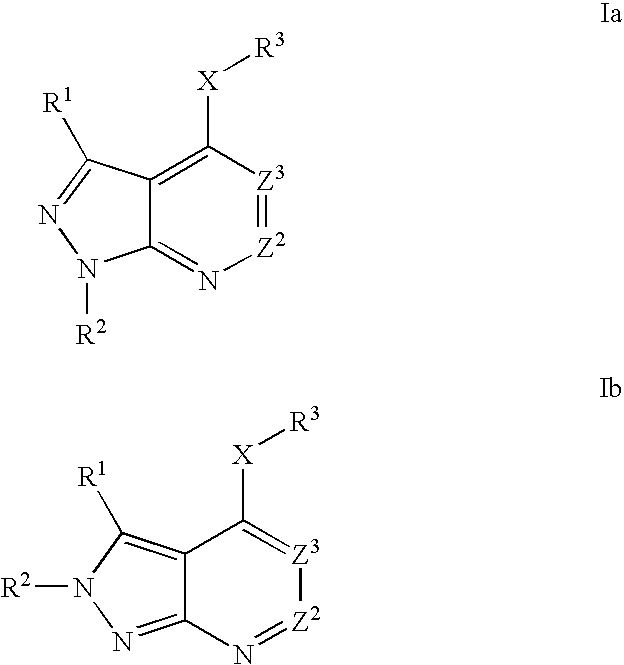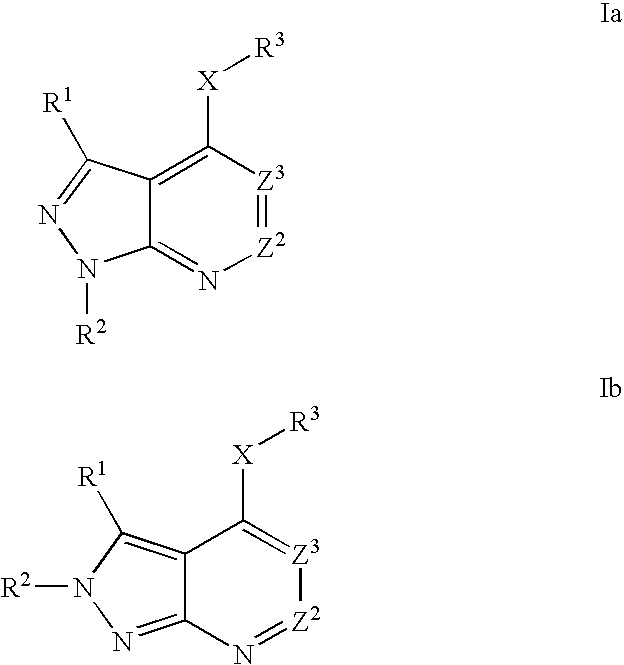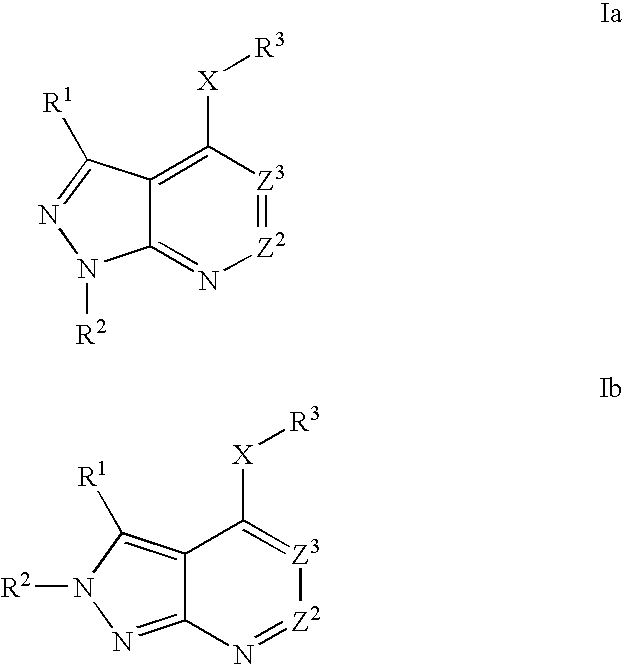Heterobicyclic pyrazole compounds and methods of use
a technology of heterobicyclic pyrazole and compounds, applied in the field of heterocyclic pyrazole compounds, can solve the problems of poor prognosis, overexpression of met and hgf,
- Summary
- Abstract
- Description
- Claims
- Application Information
AI Technical Summary
Benefits of technology
Problems solved by technology
Method used
Image
Examples
example 1
Preparation of N-(4-(1H-pyrazolo[3,4-b]pyridin-4-yloxy)-3-fluorophenylcarbamothioyl)-2-phenylacetamide
[0404]
[0405] described, and / or by making routine modifications of reaction conditions. Alternatively, other reactions disclosed herein or known in the art will be recognized as having applicability for preparing other compounds of the invention.
[0406] In the examples described below, unless otherwise indicated all temperatures are set forth in degrees Celsius. Reagents were purchased from commercial suppliers such as Aldrich Chemical Company, Lancaster, TCI or Maybridge, and were used without further purification unless otherwise indicated.
[0407] The reactions set forth below were done generally under a positive pressure of nitrogen or argon or with a drying tube (unless otherwise stated) in anhydrous solvents, and the reaction flasks were typically fitted with rubber septa for the introduction of substrates and reagents via syringe. Glassware was oven dried and / or heat dried.
[0...
example 2
Preparation of N-(4-(1H-pyrazolo[3,4-b]pyridin-4-yloxy)-3-fluorophenyl)-N-(4-fluorophenyl)cyclopropane-1,1-dicarboxamide
[0415]
[0416] Step A: Preparation of N-(4-(1-(4-methoxybenzyl)-1H-pyrazolo[3,4-b]pyridin-4-yloxy)-3-fluorophenyl)-N-(4-fluorophenyl)cyclopropane-1,1-dicarboxamide: To a stirred mixture of 4-(1-(4-methoxybenzyl)-1H-pyrazolo[3,4-b]pyridin-4-yloxy)-3-fluorobenzenamine (73 mg, 0.20 mmol; obtained from Example 1, Step D) and ((4-fluorophenyl)carbamoyl)cyclopropanecarboxylic acid (49 mg, 0.220 mmol; prepared from cyclopropane-1,1-dicarboxylic acid and 4-fluoroaniline using the methods of WO 2005 / 030140 and by Shih and Rankin, Synth. Comm. 1996, 26(4), 833-836) in DMA (2 mL) was added N1-((ethylimino)methylene)-N3,N3-dimethylpropane-1,3-diamine hydrochloride (EDCI) (77 mg, 0.400 mmol). The reaction was stirred for 1 hour at room temperature. The reaction was diluted with EtOAc (10 mL) and water (10 mL). The phases were separated, and the organic phase washed with water (3...
example 3
Preparation of N-(3-fluoro-4-(1-methyl-1H-pyrazolo[3,4-b]pyridin-4-yloxy)phenyl)-N-(4-fluorophenyl)cyclopropane-1,1-dicarboxamide
[0418]
[0419] Step A: Preparation of 4-(2-fluoro-4-nitrophenoxy)-1H-pyrazolo[3,4-b]pyridine: A stirred mixture of 1-(4-methoxybenzyl)-4-(2-fluoro-4-nitrophenoxy)-1H-pyrazolo[3,4-b]pyridine (27.6 g, 70.0 mmol; obtained from Example 1, Step C) and TFA (53.9 mL, 700 mmol) was heated to reflux for 18 hours under N2. The reaction was allowed to cool to room temperature, and then concentrated in vacuo using toluene (4×100 mL) to azeotrope residual TFA. The residue was diluted with EtOAc (200 mL) and carefully neutralized (pH=8-9) with saturated aqueous NaHCO3 (100 mL). The biphasic suspension was stirred at room temperature for 30 minutes. The suspension was filtered. The resulting solid was dried by toluene azeotrope (2×200 mL) to obtain the product (18.7 g, 97%). 1H NMR (DMSO-d6, 400 MHz) δ 13.85 (br s, 1H), 8.40 (m, 2H), 8.15 (m, 1H), 7.91 (s, 1H), 7.66 (m, 1...
PUM
| Property | Measurement | Unit |
|---|---|---|
| Force | aaaaa | aaaaa |
| Equivalent mass | aaaaa | aaaaa |
| Structure | aaaaa | aaaaa |
Abstract
Description
Claims
Application Information
 Login to View More
Login to View More - R&D
- Intellectual Property
- Life Sciences
- Materials
- Tech Scout
- Unparalleled Data Quality
- Higher Quality Content
- 60% Fewer Hallucinations
Browse by: Latest US Patents, China's latest patents, Technical Efficacy Thesaurus, Application Domain, Technology Topic, Popular Technical Reports.
© 2025 PatSnap. All rights reserved.Legal|Privacy policy|Modern Slavery Act Transparency Statement|Sitemap|About US| Contact US: help@patsnap.com



